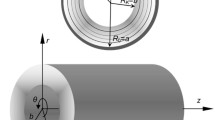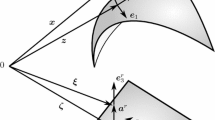Abstract
In this paper, the linearly conforming radial point interpolation method is extended for geometric nonlinear analysis of plates and cylindrical shells. The Sander’s nonlinear shell theory is utilized and the arc-length technique is implemented in conjunction with the modified Newton–Raphson method to solve the nonlinear equilibrium equations. The radial and polynomial basis functions are employed to construct the shape functions with Delta function property using a set of arbitrarily distributed nodes in local support domains. Besides the conventional nodal integration, a stabilized conforming nodal integration is applied to restore the conformability and to improve the accuracy of solutions. Small rotations and deformations, as well as finite strains, are assumed for the present formulation. Comparisons of present solutions are made with the results reported in the literature and good agreements are obtained. The numerical examples have demonstrated that the present approach, combined with arc-length method, is quite effective in tracing the load-deflection paths of snap-through and snap-back phenomena in shell problems.
Similar content being viewed by others
References
MacNeal RH, Harder RL (1985) A proposed standard set of problems to test finite element accuracy. Finite Elem Anal Des 1: 3–20
Belytschko T, Stolarski H, Liu Wk, Carpenter N, Ong JSJ (1985) Stress projection for membrane and shear locking in shell finite elements. Comput Methods Appl Mech Eng 51: 221–258
Simo J, Fox DD (1989) On a stress resultant geometrically exact shell model, part I: formulation and optimal parameterization. Comput Methods Appl Mech Eng 72: 267–304
Simo J, Fox DD, Rifai MS (1989) On a stress resultant geometrically exact shell model, part II: the linear theory. Comput Methods Appl Mech Eng 73: 53–92
Sabir AB, Lock AC (1973) The application of finite elements to the large deflection geometrically nonlinear behaviour of cylindrical shells. In: International conference on variational methods in engineering, Southampton, England, pp 7/67–7/76
Bergan PG, Nygard MK (1985) Nonlinear shell analysis using free formulation finite elements. In: Finite element methods for nonlinear problems, Europe–US Symposium, Tronhelm, Norway
Palazotto AN, Dennis ST (1992) Nonlinear analysis of shell structures. AIAA education series, Wahsington DC
Choi CK, Paik JG (1996) An effective four node degenerated shell element for geometrically nonlinear analysis. Thin-Walled Struct 24: 261–283
Sze KY, Zheng SJ (1999) A hybrid-stress nine-node degenerated shell element for geometrical nonlinear analysis. Comput Mech 23: 448–456
Sze KY, Chan WK, Pian THH (2002) An eight-node hybrid-stress solid-shell element for geometric nonlinear analysis of elastic shells. Int J Numer Methods Eng 55: 853–878
Hauptmann R, Schweizerhof K (1998) A systematic development of solid-shell element formulations for linear and nonlinear analyses employing only displacement degrees of freedom. Int J Numer Methods Eng 42: 49–69
Reddy JN (2004) Mechanics of laminated composite plates and shells: theory and analysis, 2nd edn. CRC Press, Baca Raton
Arciniega RA, Reddy JN (2007) Large deformation analysis of functionally graded shells. Int J Solids Struct 44: 2036–2052
Krysl P, Belytschko T (1996) Analysis of thin shells by the element-free Galerkin method. Int J Solids Struct 33: 3057–3080
Noguchi H, Kawashima T, Miyamura T (2000) Element free analyses of shell and spatial structures. Int J Numer Methods Eng 47: 1215–1240
Li S, Hao W, Liu WK (2000) Numerical simulations of large deformation of thin shell structures using meshfree methods. Comput Mech 25: 102–116
Wang JG, Liu GR (2002) A point interpolation meshless method based on radial basis functions. Int J Numer Methods Eng 54: 1623–1648
Liu GR, Gu YT (2001) A point interpolation method for two-dimensional solids. Int J Numer Methods Eng 50: 937–951
Liu GR, Dai KY, Lim KM, Gu YT (2003) A radial point interpolation method for simulation of two-dimensional piezoelectric structures. Smart Mater Struct 12: 171–180
Zhang GY, Liu GR, Wang YY, Huang HT, Zhong ZH, Li GY, Han X (2007) A linearly conforming point interpolation method (LC-PIM) for three-dimensional elasticity problems. Int J Numer Methods Eng 72: 1524–1543
Liu GR, Li Y, Dai KY, Luan MT, Xue W (2006) A linearly conforming RPIM for solids mechanics problems. Int J Comput Methods 3: 401–428
Beissel S, Belytschko T (1996) Nodal integration of the element-free Galerkin method. Comput Methods Appl Mech Eng 139: 49–74
Bonet J, Kulasegaram S (1999) Correction and stabilization of smoothed particle hydrodynamics methods with applications in metal forming simulations. Int J Numer Methods Eng 47: 1189–1214
Chen JS, Wu CT, Yoon S, You Y (2001) A stabilized conforming nodal integration for Galerkin mesh-free methods. Int J Numer Methods Eng 50: 435–466
Crisfield MA (1997) Non-linear finite element analysis of solids and structures, vol 2. Wiley, Chichester
Sze KY, Chen JS, Sheng N, Liu XH (2004) Stabilized conforming nodal integration: exactness and variational justification. Fin Elem Anal Des 41: 147–171
Sanders JL Jr (1963) Nonlinear theories for thin shells. Q Appl Math 21: 21–36
Flügge W (1973) Stresses in shells, 2nd edn. Springer, Berlin
Sze KY, Liu XH, Lo SH (2004) Popular benchmark problems for geometric nonlinear analysis of shells. Fin Elem Anal Des 40: 1551–1569
Author information
Authors and Affiliations
Corresponding author
Rights and permissions
About this article
Cite this article
Zhao, X., Liu, G.R., Dai, K.Y. et al. Geometric nonlinear analysis of plates and cylindrical shells via a linearly conforming radial point interpolation method. Comput Mech 42, 133–144 (2008). https://doi.org/10.1007/s00466-008-0242-x
Received:
Accepted:
Published:
Issue Date:
DOI: https://doi.org/10.1007/s00466-008-0242-x




